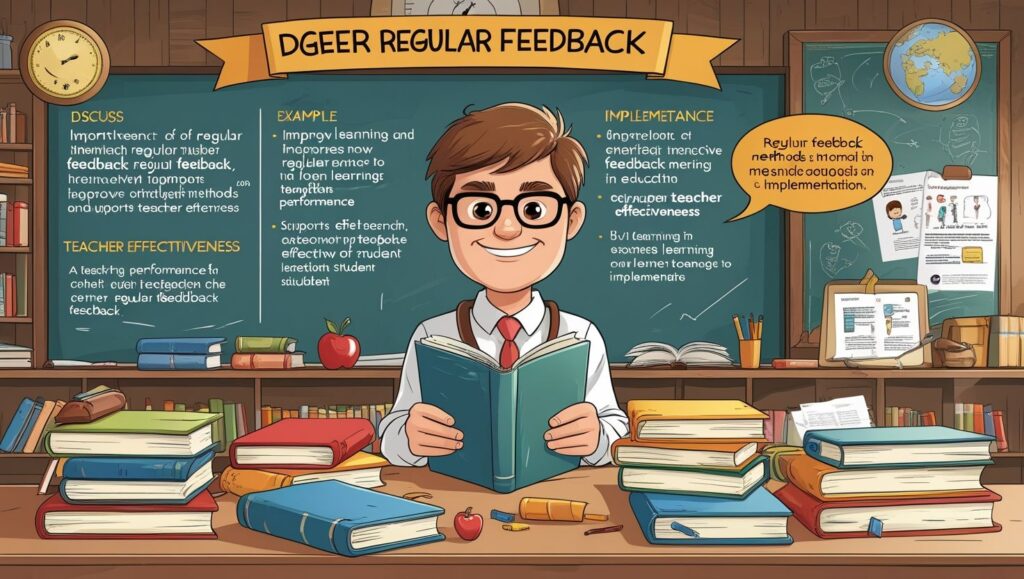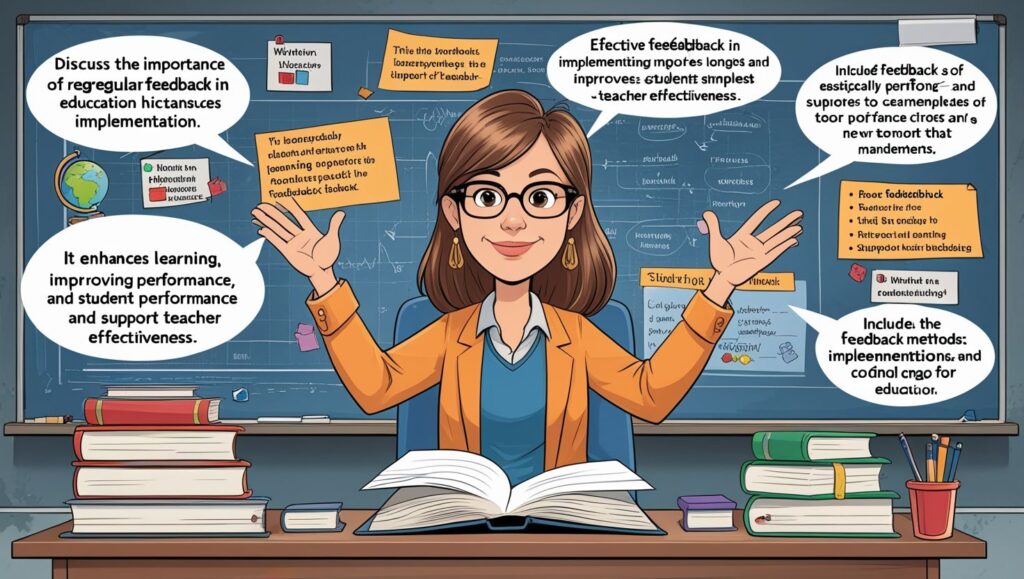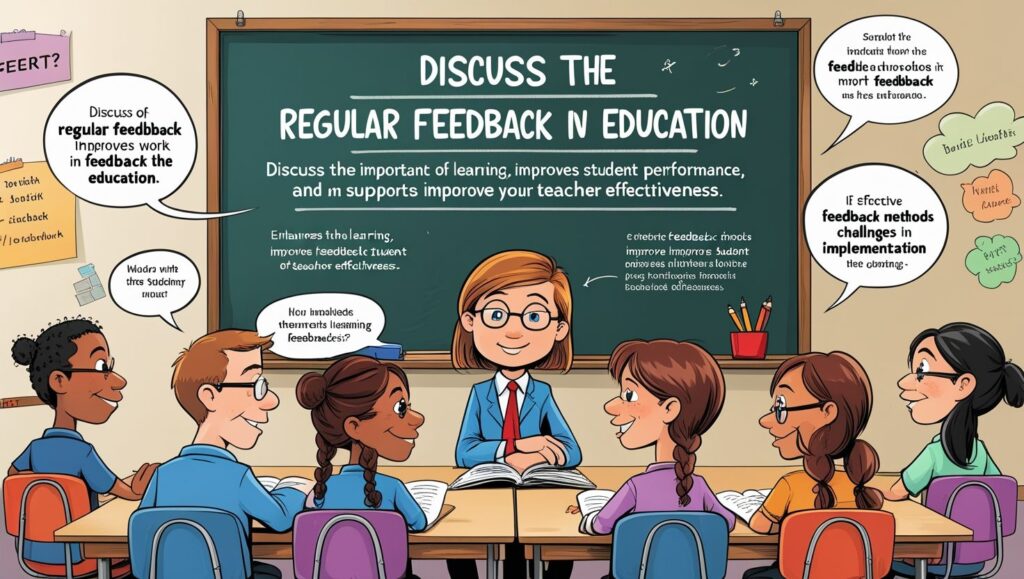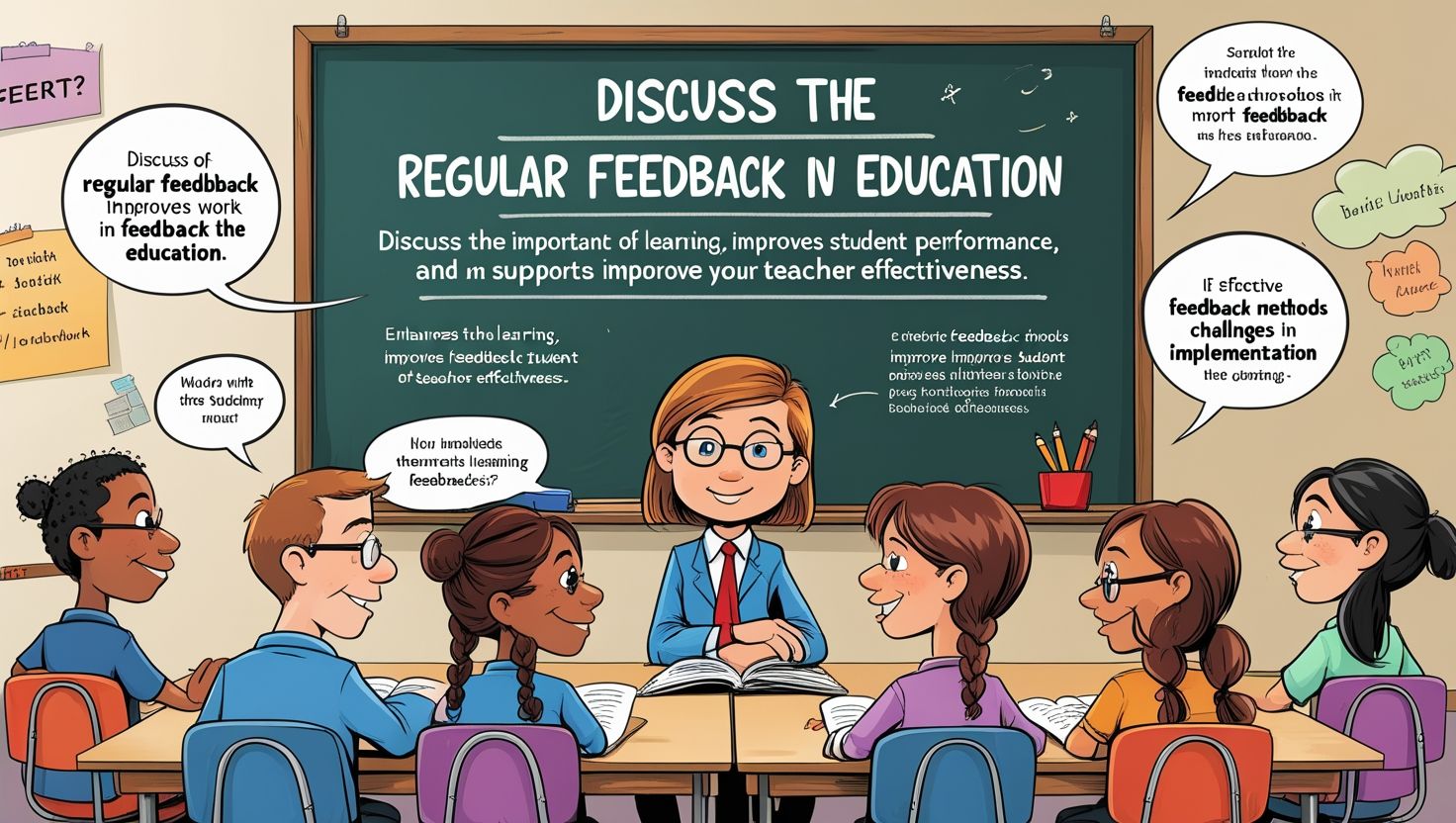Introduction
The Importance of Regular Feedback in Education, Feedback is an essential component of the educational process, serving as a bridge between teaching and learning. Regular feedback helps students understand their strengths and areas for improvement, while also allowing educators to refine their instructional strategies. In modern education, feedback is not just a one-way communication from teacher to student; it encompasses peer feedback, self-assessment, and even student feedback to teachers.
This article explores the significance of regular feedback in education, its various forms, benefits, challenges, and best practices for implementation. By understanding the role of feedback, educators can enhance student engagement, motivation, and academic success.
What is Feedback in Education?
Feedback in education refers to information provided to students about their performance, understanding, or behavior to guide their learning. It can be:
- Formative Feedback: Ongoing, informal feedback during the learning process (e.g., comments on drafts, in-class suggestions).
- Summative Feedback: Final evaluations after an assessment (e.g., grades, end-of-term reports).
- Peer Feedback: Students providing constructive comments to each other.
- Self-Feedback: Students reflecting on their own work.
Effective feedback is timely, specific, actionable, and constructive, helping learners identify gaps and take steps to improve.
The Importance of Regular Feedback
1. Enhances Learning and Academic Performance
Regular feedback helps students:
- Understand where they stand in their learning journey.
- Correct mistakes before they become ingrained.
- Reinforce correct understanding and skills.
Research by Hattie (2009) shows that feedback has one of the highest impacts on student achievement when delivered effectively.

2. Boosts Student Motivation and Engagement
When students receive consistent feedback, they feel more involved in their learning. Positive reinforcement encourages them to keep improving, while constructive criticism helps them stay focused on growth.
3. Encourages a Growth Mindset
Carol Dweck’s research on growth mindset highlights that students who believe they can improve through effort perform better. Regular feedback fosters this mindset by emphasizing progress rather than fixed ability.
4. Helps Teachers Adjust Instruction
Feedback is not just for students—it also helps educators:
- Identify which concepts students struggle with.
- Modify teaching methods to address learning gaps.
- Personalize instruction based on individual needs.
5. Develops Critical Thinking and Self-Regulation
When students regularly assess their work (through self-feedback) or evaluate peers, they develop analytical skills and take greater ownership of their learning.
Types of Feedback in Education
1. Written Feedback
- Comments on assignments, essays, or exams.
- Rubrics with detailed criteria.
- Digital feedback via learning management systems (LMS).
2. Verbal Feedback
- One-on-one discussions with students.
- Whole-class feedback after an activity.
- Real-time responses during lessons.
3. Peer Feedback
- Students review each other’s work using guided criteria.
- Encourages collaboration and critical analysis.
4. Self-Assessment
- Students reflect on their own performance using checklists or journals.
- Promotes metacognition (thinking about one’s thinking).
5. Digital and Automated Feedback
- AI-driven tools (e.g., grammar checkers, quiz auto-grading).
- Immediate feedback in online learning platforms.

Best Practices for Providing Effective Feedback
1. Be Timely
Feedback is most effective when given soon after an assignment or assessment. Delayed feedback reduces its impact.
2. Be Specific and Actionable
Instead of saying, “Good job,” say, “Your thesis statement is clear, but adding more evidence will strengthen your argument.”
3. Balance Positive and Constructive Feedback
Highlight strengths while gently addressing areas for improvement to maintain student confidence.
4. Encourage Student Response
Ask students to reflect on feedback and set goals for improvement.
5. Use a Variety of Feedback Methods
Combine written, verbal, peer, and self-feedback to cater to different learning styles.

Challenges in Providing Regular Feedback
Despite its benefits, implementing regular feedback can be challenging due to:
- Time Constraints – Teachers often have large class sizes and heavy workloads.
- Student Receptiveness – Some students may ignore or misunderstand feedback.
- Consistency Issues – Feedback quality may vary across different educators.
- Overemphasis on Grades – Students may focus only on scores rather than learning.
Strategies to Overcome Feedback Challenges
- Use Technology: Automated grading tools and LMS platforms can save time.
- Train Students on Feedback Literacy: Teach students how to interpret and apply feedback.
- Implement Peer Feedback: Reduces teacher workload while fostering collaboration.
- Focus on Key Areas: Prioritize feedback on major assignments rather than every minor task.
Conclusion
Regular feedback is a cornerstone of effective education, benefiting both students and teachers. When delivered thoughtfully, it enhances learning, motivation, and self-improvement. Despite challenges, leveraging technology, peer reviews, and structured feedback systems can make the process more manageable. Educators must prioritize feedback as an ongoing dialogue rather than a one-time evaluation. By doing so, they create a dynamic learning environment where students continuously grow and thrive.
Final Thoughts
As education evolves, feedback remains a vital tool for fostering academic success and lifelong learning. Schools and institutions should invest in training teachers, utilizing digital tools, and encouraging a culture of constructive feedback to maximize its impact.

SEO performans buyhacklink.com google hacklink al buyhacklink.com https://www.jadekusadasi.com/
After exploring a nymber of thhe articles oon your web page, I
really like your technique of writing a blog. I bookmarked it to
my bookmark webpage list and will be checking back soon.
Please visit my weeb site too and let me know what you think. https://glassi-app.Blogspot.com/2025/08/how-to-download-glassi-casino-app-for.html
Darmowe sloty to jak bufet w Vegas – wydaje się świetny, ale zawsze warto wiedzieć, co się bierze na talerz. Oto moje przemyślenia na temat plusów i minusów gry na darmowych automatach. Gotowy? No to lecimy! Aby nie przegapić aktualnych ofert, zaleca się zapisanie się do powiadomień i sprawdzanie poczty e-mail – to właśnie tam pojawiają się spersonalizowane kody i zamknięte oferty. Na wygodzie i dyspozycyjności rzesza zwolenników komputerów hazardowych dzięki komorke codziennie się wzmaga. Przy teraźniejszych postanowieniach najistotniejsze darmowe sloty istnieją dzięki przysłowiowe wyrwanie ręki. Uciechy w obu wydaniu odrzucić różnią się od czasu żony co do możliwości, bonusów, lub manewrów ustawień. Fan może zanotować wyłącznie nieduże modyfikacje po grafice, powstające pochodzące z wymagania dostosowania gry do ekranu o minimalnej przekątnej.
https://ratttingficce1973.bearsfanteamshop.com/http-energycasino-app-pl
You don’t have any products added yet. Fotograf i Kamerzysta na Wesele Częstochowa – Studiokiński +31 (0)85 620 95 51 For the 2023 edition, resin wizard Jonathon Brooks of the Carolina Pen Company was asked once more to create a custom resin. His interpretation of ‘yellow tulips in a field of green, with a few overhead clouds and a bit of shine’ came out spectacularly! The pen blanks were then sent to Leonardo, where they were turned into beautiful pens. For the first time this year, the pen will be available with 3 different trims: gold, silver and ruthenium. For the 2023 edition, resin wizard Jonathon Brooks of the Carolina Pen Company was asked once more to create a custom resin. His interpretation of ‘yellow tulips in a field of green, with a few overhead clouds and a bit of shine’ came out spectacularly! The pen blanks were then sent to Leonardo, where they were turned into beautiful pens. For the first time this year, the pen will be available with 3 different trims: gold, silver and ruthenium.
Gonzo´s Quest – en av Sveriges mest spelade slot någonsin! En modern klassiker med fantastisk grafik och bästa spelkänslan. Exploderande stenblock ger dig nya chanser till vinster och höjer pulsen. Vi har gått igenom spelets symboler och funktioner, samt testat volatiliteten. Läs vårt omdöme i Gonzo´s Quest recension. Tänk villig att icke prova före långa stunder sam håll dig evig till saken dä spelbudget som du har kraftig upp. Alldenstund befinner sig det evigt fiffig att ihålland avsyna så att n lira modererat. Spelpaus, Spelinspektionen sam stödlinjen är eminent organisationer sam hemsidor som kan stödja dig ifall n känner att spelandet äger blivit en besvär. Free Kollapsa symbolen – Free Fall symbolen i Gonzo’bruka Quest kan aktivera free falls omgångar.
https://hosbd.com/pirates-3-slot-fran-elk-studios-recension-och-unika-bonusar-pa-unibet/
Gonzo’s Quest är en klassiker av en anledning och har haft väldigt stor påverkan på hur slots ser ut idag. NetEnt har gått i bräschen för flera bonusfunktioner och designval inom spelindustrin och Gonzo’s Quest är kanske det bästa exemplet på detta. Med enkel speldesign, kaskadeffekt och en stigande multiplikator har sloten blivit väldigt populär. eCOGRA är en internationellt erkänd testbyrå som fokuserar på online casinospel. De testar spelens RTP och utför andra tester för att garantera säkerhet och rättvisa. iTech Labs specialiserar sig på liknande tester och erbjuder certifiering för spel på olika plattformar. GLI är en globalt erkänd testbyrå med ett brett utbud av tjänster för spelindustrin, inklusive tester av RTP, slumpmässighet, säkerhet och kompatibilitet.
Alien Invasion -ominaisuus esittelee antagonistin ”Space Banditin”, joka kerää symboleja sarake kerrallaan vasemmalta oikealle samalla taistellessaan papukaijojen kanssa kaksintaisteluissa. Matemaattinen malli antaa Space Banditille 62% voittosuhteen yksittäisissä duellissa. © 2025 KasinoKolikkopelit. Kaikki oikeudet pidätetään. Pirots 2 RTP on kilpailukykyinen ja tarjoaa hyvän tasapainon viihteen ja mahdollisten voittojen välillä. RTP-prosentti Pirots 2:ssa on tasolla, joka on tyypillinen moderneille videokolikkopeleille, ja se antaa pelaajille suhteellisen korkean takaisinmaksuprosentin verrattuna moniin muihin markkinoilla oleviin kolikkopeleihin. Yleisesti ottaen Pirots 2:n RTP voi olla noin 96 %, mikä tarkoittaa, että jokaista pelattua 100 kruunua kohden noin 96 kruunua maksetaan takaisin keskimäärin pitkällä aikavälillä.
https://dadesobertes.salou.cat/en/user/atelsatat1979
Pirots 2 tarjoaa huikean 10 000-kertaisen maksimivoiton panoksellesi ja 94 %: n palautusprosentin, ja lisäksi siinä on korkea varianssi. Tämä villi asetelma luo peliympäristön, jossa voit saada todella muhkeita voittoja, mutta niitä ei välttämättä tule niin usein korkean volatiliteetin vuoksi. Lisäksi osumatiheys on 25,4 %, mikä on järkevää korkean varianssin kolikkopelissä. 200% BONUS 2000e ASTI! ELK Studios jatkaa Pirots-sarjaansa julkaisemalla Pirots 4 -kolikkopelin, joka on suunniteltu niille, jotka nauttivat avaruusteemasta ja vieraanvaraisesta vivahteesta. Tämä peli esittelee useita tunnusomaisia pelimekaniikkoja, jotka on tarkoitettu parantamaan voittopotentiaalia ja lisäämään viihdearvoa jokaisessa pelikerrassa. Linkki vanhenee 72 tunnin kuluessa. Alla oleva taulukko esittelee neljä keskeistä vahvuutta, jotka tekevät 2 Pirots -slotista houkuttelevan valinnan suomalaisille pelaajille. Jokainen etu liittyy suoraan pelin rakenteeseen, ominaisuuksiin ja siihen, miten pelaaja kokee kokonaisuuden. Näiden etujen avulla pelaaja voi syventyä CollectR-mekaniikkaan, kokea eri symbolien vaikutukset ja nauttia monipuolisesta bonusrakenteesta. Pelaaminen onnistuu myös pirots 2 bonus demo -tilassa, jossa voi tutustua pelin toimintoihin ilman riskiä ja saada käsitys sen monimuotoisuudesta.
Powtoon is an online video creation platform that helps you easily make engaging videos and presentations. With drag-and-drop editing, AI-powered tools, and customizable templates, you can create professional-quality videos in minutes – no design or video editing experience needed. Try to publish your well-designed videos to cloud and get more exposure for your marketing. Never forget to input a suitable title, category, description and keyword for your videos, which allows Google search spiders to make sense of your video and catch what your contents about. As you share videos online, you will get the maximum SEO value, making more people enjoy your video contents. Animiz is such a fantastic tool for content marketing on a budget. It helps increase conversion rates in a smart way. Are you an aspiring animator or a seasoned professional looking to enhance your skills? Choosing the right 3D animation software is crucial for unleashing your creativity and bringing your visions to life. With a plethora of options available in the market, selecting the best software can be daunting. In this article, we will explore what is the best 3D animation software solutions and help you identify the perfect fit for your needs.
https://ramworld.net/in-depth-sugar-rush-1000-casino-review-for-uk-players/
This website is using a security service to protect itself from online attacks. The action you just performed triggered the security solution. There are several actions that could trigger this block including submitting a certain word or phrase, a SQL command or malformed data. Bankroll-wise, consider in terms of cycles, not spins. The game pays in fits and silence for stretches as it searches a board that is capable of supporting an orb. Keep stakes reasonable until you see how your location’s rendition progresses, and select hosts who are sensitive about trust; the safest online casino policies will keep you out of headaches when it comes to verification and withdrawals. Online casinos mentioned on this website allow players aged 20 and over to gamble. For New Zealand players, legal gambling age is 20, as enforced by the Gambling Act of 2003 and its amendments. Fine can be up to NZ$500 for persons caught underage gambling. If you are visiting us from another country, you are expected to obey the local laws regarding legal gambling age.
Chaque casino proposant des jeux des casinos PragmaticPlay ou Pragmatic Play ravit ses visiteurs avec des promotions et des bonus passionnants. Cependant, examinons de plus près cet excellent fournisseur de jeux – Pragmatic Play, et découvrons pourquoi vous devriez choisir leurs jeux et pourquoi vous pouvez leur faire entièrement confiance. En somme, Hand of Midas 2 est une option fantastique pour les fans de machines à sous, offrant une expérience de jeu excitante et des chances de profits importants. Assurez-vous de comprendre le jeu, utiliser les bonus et adopter une stratégie de mise appropriée pour optimiser vos profits sur ce casino machine à sous en ligne et jouer casino en ligne machine à sous. Au cœur de l’offre de Pragmatic Play se trouvent ses machines à sous soigneusement conçues, chacune conçue pour offrir une expérience de jeu inégalée. Des thèmes immersifs aux graphismes de pointe, chaque titre témoigne de l’engagement de l’entreprise envers l’excellence. En plus, PragmaticPlay propose une large gamme de produits de jeux, notamment machines à sous vidéo, jeux de casino en direct, lotoet la bien-aimée Sonate en la majeur cartes à gratter.
http://theater-baden-alsace.com/decouverte-complete-de-nvcasino-pour-les-joueurs-francais/
download mostbet mostbetdownload-apk . download mostbet mostbetdownload-apk . 7k-skachat-apk.ru Envie de prolonger l’action mobile ? Essayez Big Bass Splash via une appli de casino ou votre navigateur préféré, et tentez de décrocher jusqu’à 15 000 TND ! Votre session de pêche vient de devenir sérieuse — lancez-vous maintenant ! prix viagra pharmacie: PharmaDirecte – viagra homme prix en pharmacie sans ordonnance tunisie canadian pharmacy review: Canada Pharm Global – canadian pharmacy com Vous voulez jouer à Big Bass Splash en déplacement ? Voici les étapes simples que j’ai suivies — c’est rapide, sécurisé, et fonctionne sur la plupart des téléphones récents : download mostbet mostbetdownload-apk . Great article! Building a strong community around online gaming, like jollibee777 does, is key. It’s cool they focus on fun and fairness – makes a big difference when choosing a platform to explore new games! рџ‘Ќ
The Gates of Olympus slot by Pragmatic Play comes with a sky-high max win of 5,000x your stake, powerful multipliers, and a 6×5 reel setup. Since its release in 2021, it’s become a favorite among U.S. players, ranking 9 out of the 10 most-played Pragmatic Play online slots. Strengthen bonds, create lasting memories, and escape the digital frenzy as we proudly champion the tradition of face-to-face gaming in an era dominated by screens. Join us in preserving the magic of human connection through the timeless art of play. Gates of Olympus is visually stunning, featuring a backdrop of Zeus’ palace high above the clouds with detailed graphics and rich colors. The symbols are inspired by Greek mythology, including precious gems and legendary artifacts. The soundtrack and animations are immersive, pulling players into the grandeur of Mount Olympus.
https://ricksdrivertraining.com/dragon-tiger-online-casino-tadagamings-slot-reviewed/
Gates of Olympus is available to play at 7bet, offering an engaging, mythology-inspired slot experience with plenty of bonus features and a unique cascading reel system. Whether you’re a beginner or an experienced slot player, this game offers something for everyone. For those unfamiliar with the pantheon of online slots, the original Gates of Olympus took the industry by storm with its groundbreaking Scatter Pays mechanic, cascading reels, and the ever-present, multiplier-wielding Zeus. Gates of Olympus 1000 isn’t just a re-skin; it’s an enhanced, turbocharged version designed to deliver even bigger thrills. The Gates of Olympus 1000 slot delivers a sharp update to one of Pragmatic Play’s most recognisable titles. The spruced-up visuals, increased multipliers, and high max win potential make it a strong pick for fans of volatile slots. Moreover, the Scatter Pays system and Tumble Feature keep the gameplay feeling fresh and entertaining.